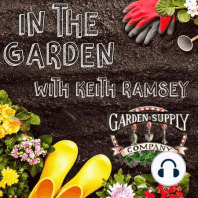11 min listen
Japanese Maples in North Carolina
FromIn The Garden
ratings:
Length:
11 minutes
Released:
Jan 26, 2021
Format:
Podcast episode
Description
Keith Ramsey: Hey, this is Keith Ramsey at the garden supply company. Today. We're going to talk about Japanese Maples. I always feel like Japanese Maples are kinda misunderstood. Everybody thinks they're extremely slow-growing and. They're really expensive. We carry a wide variety of one gallon Maples, and I've planted lots of one gallon Maples over the years.[00:01:01] There's about 3000, 4,000, maybe an unlimited number of varieties of Maples. It's not like you just have to have one Japanese maple in your yard. There are tons of different colors; there are different sizes, there are different shapes. One maple compliment another maple.[00:01:16]You can plant mixed like a mixed border of Maples. There are Maples that leaf out chartreuse. There's Maples that leaf out. Burgundy. When you break it down into two, into really two large groups, there's Palmatums, which are a large Palmate leaf, and most of that 99% are upright.[00:01:34] There's a couple of holdouts that are weeping palmatum, so that's a big Palmate, leaf. The other half of the plants are dissectums. So a dissectum is a dissected leaf. It's the Lacy leaf Japanese maple, and most of those are weeping varieties that are going to stay smaller and that that gets wider than they do tall.[00:01:55] They're typically a focal point in a landscape, and they need to be placed well. You don't want them in with a bunch of round shrubs. Because it's going to be around plants, and they'll just blend in. You want them sitting out on their own with ground cover underneath them or boulders or rocks around.[00:02:13]Both varieties do really well in North Carolina. They handle our clay really well. Some of the varieties of pushing Angie year, so they are, they're slow-growing other varieties of growth, three, three feet plus. So you can buy a one-gallon maple and have a, have full-size tree in three, four years.[00:02:32]So it's not necessarily an expensive plant. Now, a lot of times, people look at $300 plant. That's shorter than a, say, as an October glory, red maple, and, but a red maple, might push four feet of growth in a year. And it's a much, much larger tree, which is why Japanese Maples work well in the type of lots we're building on now and small courtyards.[00:02:56] it's a plant that'll grow in a pot and live in a pot for 15, 20 years if it's treated appropriately. [00:03:04] Joe Woolworth: I know that people like to go and purchase a Japanese maple, like from a big box store, but a lot of people run into a problem with their mislabeled, or they're not even the tree that, that they're [00:03:12] Keith Ramsey: purchasing.[00:03:12] And there's, and knowing what your planning is. Yes, half the, if you go and you pick something up, and it's just a seedling maple, you don't really know what you're getting. It's something that's been cross-pollinated. You pick up a hundred seeds, and every one of those plants might be genetically different.[00:03:28] The neat thing about Maples is, they are crossed, and then they're grafted a lot of times. Typically they're grafted. And they're grafted for strong rootstock. And then for whatever the beneficial qualities of the top of the plant are whether it be color or the shape of the leaf or the growth habit. [00:03:46][00:03:46]Joe Woolworth: If you're going into the garden supply company with your eyes on a Japanese maple cause you got the perfect spot in your yard, is it just as easy as just planting wherever you want? Or is there a little bit more to it than that? [00:03:56]Keith Ramsey: I think it's, it's like anything you want a tree that's going to be.[00:03:59] Portion it to this space. if you're doing an upright tree coral bark, Japanese Maples, or one of them, the top trees we sell the bark in the wintertime is a coral color. So when it doesn't have a leaf on it, The trees showing off. It looks great, and they're all Japanese Maples are asymmetrical.[00:04:17] So there, each one of them is a piece of art. Everyone's very
Released:
Jan 26, 2021
Format:
Podcast episode
Titles in the series (51)
Watering: Tips on watering plants and lawns. by In The Garden
